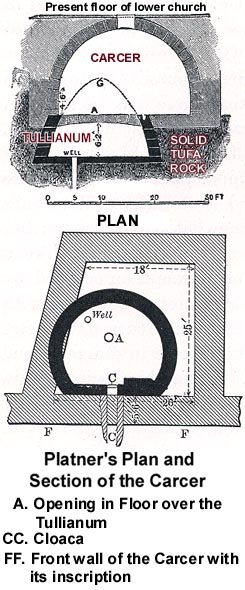
The Roman prison is located off the Clivus Capitolinus north of the scalae Gemoniae, the steps leading up to the north peak of the Capitoline Hill known as the Arx.
The Carcer consists of two chambers, an upper and a lower. In some fanciful but typical etymologies, the Romans connected the name carcer to their word for "compel" (coercere), and explained that the name of the lower level, the "Tullianum," was given because it was added to the original Carcer by King Servius Tullius. This view of the interior, though lighted for visitors and containing a modern altar, gives a sense of its black stone walls and gloomy atmosphere.
The Carcer was not a place for long-term confinement of prisoners. Accused persons would be held there until the time of their trial, and condemned persons might be kept there briefly until their executions. Cicero (In Verrem 5.77) notes that distinguished prisoners of war were executed in the lower chamber of the Carcer after they had been marched in chains in a Roman general's triumphal parade. Sallust (Catiline 55.2-6) describes the interior of the Tullianum in his own day (40s BCE): "In the Carcer there is a place, which is called the Tullianum; where you go up to the left, sunken into the ground about twelve feet. The walls fortify it on all sides, and on the top the ceiling is joined over by a stone arch. But its facade is befouled and frightening because of neglect, darkness, and smell." He goes on to describe the execution there of the most distinguished of the Catilinarian conspirators by the tresviri capitales, three minor magistrates who were in charge of carrying out capital punishments.
In a later period, the Carcer became a kind of Christian shrine because of the alleged martyrdom there of Christian saints and the rumored imprisonment of St Paul. It is now incorporated into the the lower levels of the Church San Giuseppe dei Falegnami, evidently built over the ancient entrance (view of the modern facade).
Nathaniel Hawthorne wrote a very personal response to his visit to the Carcer in the 19th century.